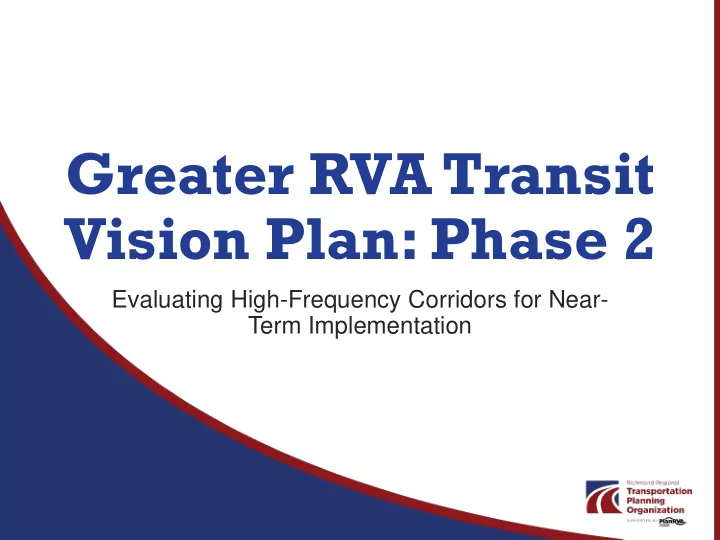

Greater RVA Transit Vision Plan: Phase 2 Evaluating High-Frequency Corridors for Near- Term Implementation
Project Purpose Build upon the Greater RVA Transit Vision Plan Phase 1 (2017) and recent transit improvements in the Richmond region Identify recommendations that can be implemented in the near term to advance toward the long-term vision in Phase 1
The Greater RVA Transit Vision Plan was endorsed in April 2017. Since then… Pulse BRT GRTC Expansion to Short Pump Implementation of the Richmond Transit Network Plan US 1/301 Transit Service Study and Demonstration Project …But what’s next?
What is the difference between Phase 1 and Phase 2? Phase 1 Phase 2 Long-range vision to 2040 Near-term implementation strategy for next 5 years Focused on future Focused on existing development conditions and near-term Identified 34 corridors of all development types (BRT, local, express) Limited to 20 high- Specified long-range frequency corridors service level for each Will determine near-term corridor service levels
Phase 1 Network Phase 2 Network
Phase 2 Analysis Plan Recommendation Screening Detailed Analysis Development Initial Phase • Activity Density 2 Segment • Employment & Workers • O&M Cost Estimates • Environmental Justice Analysis • Capital Cost Estimates & Transit-Dependency • ROI • Existing Transit • Existing Network Performance • Funding Resources Layout • Community Resources • Near-Term Refined Phase 2 • Pedestrian Facilities Development Segment • Roadway • Steering Committee Analysis Characteristics Feedback Phase 1 Corridor Review
Screening Methodology Activity Density • 2017 Employment + Population per Acre • DRPT’s Multimodal Design Guidelines recommend different types of service by different density levels
Screening Methodology Employment and Working Populations • Transit-Supportive Employment : Areas meeting DRPT’s thresholds for transit by employment alone. • High Worker Populations : Top quartile of tracts in the region of workers per square mile (approximately 1,500 workers per square mile or greater)
Screening Methodology Environmental Justice and Transit Dependent Populations • Environmental Justice : Index of several population types: low- income households, elderly populations, populations with limited English proficiency, non- white or Hispanic populations, and low vehicle ownership populations • Transit-Dependent Populations : Highest quartile of tracts by transit mode share, lowest quartile of tracts by average vehicle ownership
Recommendation Example Insert example One-Pager to walkthrough analysis, pick one: - Brook Rd? - Midlothian? - Iron Bridge?
DRAFT Phase 2 Initial Segments
DRAFT Phase 2 Initial Segments Full Phase 1 Partial Phase 1 Phase 1 Corridor Corridor: Corridor: Not Recommended for Near-Term: • Broad Street - • Midlothian Turnpike Short Pump • West End South • Hull Street • Airport via Route 60 • Route 1 to Ashland • Mechanicsville Turnpike • West End Route 6 – Staples • Laburnum Avenue – Willow • Jeff Davis South to Mill/Route 33 Lawn to Airport Chester • Route 5 South • Glenside to Midlothian • Lee Davis Road • Iron Bridge Road – City to Jeff Davis • Warwick Road • West End and Midlothian • West End Route 3 – • West End Route 4 – Lauderdale Pemberton Nuckols • West End Route 5 – • West End Route 7 – Innsbrook Regency to Azalea
Next Steps Revise initial segments based on stakeholder feedback Detailed analysis on initial segments: Nearby community facilities Roadway and pedestrian infrastructure Existing transit performance Develop recommended level of transit service for each corridor: Headways and Hours of Service Ridership Projections Capital and Operating Costs Potential Funding and Revenue Sources Prioritize package of corridors for near-term implementation
Schedule August September October November December January Screening Detailed Analysis Recommendations Development Steering Committee composed of GRTC, DRPT, City of Richmond, Henrico County, Chesterfield County, Hanover County, Town of Ashland, RideFinders, and CTAC representatives
Recommend
More recommend